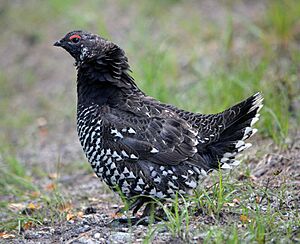Siberian grouse facts for kids
Quick facts for kids Siberian grouse |
|
|---|---|
 |
|
| Conservation status | |
| Scientific classification | |
| Genus: |
Falcipennis
|
| Species: |
falcipennis
|
| Synonyms | |
|
Dendragapus falcipennis |
|
The Siberian grouse (Falcipennis falcipennis) is a small, round bird that lives in forests. People also call it the Siberian spruce grouse or Amur grouse. This bird stays in one place and does not migrate. It is the only type of bird in its group, called Falcipennis. There's another bird, the spruce grouse in North America, that looks similar. But it belongs to a different group.
Contents
What Does the Siberian Grouse Look Like?
Adult Siberian grouse are about 38–43 centimetres (15–17 in) long. Males usually weigh between 580–735 grams (1.279–1.620 lb). Females are a bit heavier, weighing 650–740 grams (1.43–1.63 lb).
Both male and female grouse have white speckles. These spots are on their belly, sides, and under their tail. They also have white stripes on their wings and back. The tip of their tail has a white band.
- Males: They have dark brownish-grey feathers. They have a fluffy ruff of feathers around their neck. They also have a black patch under their chin, outlined in white. Above each eye, males have a patch of red skin.
- Females: They are lighter brown than males. Females do not have the strong face markings that males do.
Where Do Siberian Grouse Live?
The Siberian grouse lives in eastern Siberia and the Russian Far East. You can find them in places like Primorsky Krai and Khabarovsk Krai. A small group used to live in northeast China, but they are probably gone now.
These birds like moist, shady forests with lots of trees. They especially like forests with Ezo spruce, Korean pine, and Dahurian larch. They also live in mixed forests that have open glades.
They prefer areas with a thick layer of moss and berry bushes on the ground.
What Do They Eat?
Siberian grouse mainly eat conifer needles. In summer and fall, they also eat berries. These include cranberry and other berries from plants like Vaccinium and Empetrum. They also eat leaves from shrubs like Rubus.
How Do They Live?
In autumn, these grouse gather in small groups. These groups can have up to 10 or 11 birds. Often, these groups are made up of females and younger males.
In winter, they often sleep in burrows they dig in the snow. If the weather is milder, they might sleep high up in trees instead.
Behaviour and Life Cycle
Every spring, male grouse show off to attract females. They flick their tails and puff up their neck feathers. They also make a soft cooing sound that gets higher in pitch. Then, they jump and spin twice in the air, clapping their wings.
Females might visit these display areas from late April to mid-May. Older males (over 3 years old) are usually the ones that mate.
Nests and Eggs
The nest is a simple dip in the dirt floor. It is lined with small sticks and pine needles. Females lay 6 to 12 eggs. The eggs are a tawny-buff color with dark rusty spots. The mother bird sits on the eggs for about 23 to 24 days until they hatch.
Why Are Siberian Grouse Important?
The Siberian grouse is listed as "Near Threatened" by BirdLife International. This means their numbers are decreasing. The main reasons are:
- Loss of their forest home.
- Illegal logging (cutting down trees).
- Too much hunting.
- Forest fires.
Because of this, the Siberian grouse can be an indicator species. This means they show how healthy the Amur forests in Far East Russia are. If the grouse are struggling, it means the forest is too. Protecting these birds is very important to help them survive.
Studying the Siberian Grouse
Scientists are learning more about the Siberian grouse. They study them at the Karasuk Research Station in Novosibirsk, Russia. This station is part of the Institute of Systematics and Ecology of Animals.
They have a special breeding program. This program helps them learn about the grouse's natural behaviors. They also study what threatens the birds in the wild. If needed, they can release birds raised in captivity back into the wild.
It can be hard to raise Siberian grouse in captivity. They have very specific needs.
- They can get sick easily from diseases that affect other birds.
- Their diet is special; they mostly eat conifer needles and berries.
- They often don't seem afraid of people. Instead of flying away, they might just freeze or keep doing what they were doing.
Researcher Alexander Andreev studied how predators affect Siberian grouse in winter. He found that owls are a big threat. Grouse try to avoid landing on snow during the day. They also try to move quietly to avoid being heard. Andreev also noticed that grouse spread out at night to avoid predators. During the day, they gather in groups to socialize.


